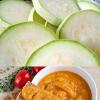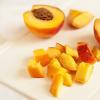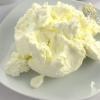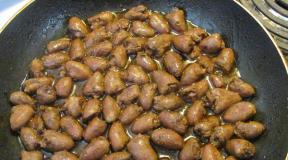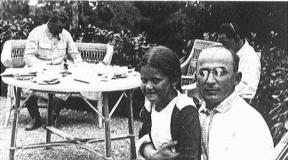Plum Baikal amber variety description. How to grow plums in Siberia and other northern regions. Growing plums in Siberia
Many gardeners are engaged in growing plums not only in the south of the country, but also in the regions middle zone. Thanks to the work of breeders, many winter-hardy varieties have been developed that are suitable for growing in regions with harsh winters. Today we will tell you briefly about these varieties, as well as how plums are grown in Siberia, planting and caring for this plant, and much more.
- Growing plums in Siberia
- Plum care
- Pruning plum trees
- Crown formation
The most common Siberian plum varieties

- Ussuriyskaya. A medium-sized species, reaching 4 meters in height at maturity. The first fruiting begins in the trees three years old. It bears fruit with red or yellow berries that are difficult to transport. Fruiting occurs in late August - early September. Ussuri plum is a moisture-loving plant. Due to lack of moisture root system the plant becomes weaker and more vulnerable to disease and frost.
- Canadian plum and American plum are winter-hardy, drought-resistant varieties and very similar in agricultural technology. The height of adult specimens reaches 5 m.
- The most common Siberian variety is the Karzin plum, bred by crossing two overseas species. This is a heat-loving variety that is suitable for cultivation in the southern regions of Siberia.
- Russian plum or as it is also called cherry plum. This is a hybrid variety that is resistant to cold, heat and sudden temperature changes, and is easily rehabilitated after damage. This plant bears small but very tasty fruits, the shelf life of which is no more than ten days. The first fruits begin to ripen in early July. The last harvest can be harvested at the end of August.
- You can achieve the highest possible yield of plums if you use varieties specifically designed for this growing zone. For example, in the Urals, gardeners use the Pride of the Urals plum variety. This is the only variety suitable for cultivation in this region.

Plum seedlings for Siberia and the northern regions “Manchurian Beauty” and “Yellow Khopty” are productive and easy-to-care plants. The good winter hardiness and high survival rate of these varieties attracts many gardeners for further cultivation.
Hybrid varieties bred by breeders of Buryatia are best suited for snowy zones: “Daughter of Buryatia”, “Neznakomka”, “Nakhodka” and “Baikal Yantar”.
Growing plums in Siberia

Planting and caring for plums in Siberia is not a complicated process and is accessible to any gardener, even a beginner. The ideal place for planting this crop is a sunny area where there are no winds or drafts with loose, organic-rich sandy or loamy soil.
This crop is planted in Siberia in early spring or autumn. The distance between seedlings is determined based on the plant variety. Vigorous species with a spreading crown are planted at a distance of 3 meters from each other, medium-sized and dwarf varieties– placed at intervals of 1.5-2 m.
When planting a plum, it is very important not to damage its root system, so it requires a deep and wide planting hole - 50x100 cm. A complex fertilizer consisting of 5 kg of rotted manure, 250 g of superphosphate and 100 potassium fertilizers is placed at the bottom of the hole. If planting is carried out in an area with heavy soil, then it would not be a bad idea to add 5 kg of sand to this mixture. This feeding will provide adequate nutrition to the seedlings for several years. If the planting of a plum orchard is carried out on acidic soil, then before planting the plants, lime is added to the hole (60 g of the substance is consumed per 1 planting hole).
The root system of young trees is very sensitive to fertilizers, so it is isolated. The nutrient layer is sprinkled with black soil, and the roots are laid on top of it. The tree is planted so that the root collar is level with the ground. Planted young trees are watered abundantly and mulched with a 5-centimeter layer of organic matter.
Plum care

One of the main conditions successful cultivation This crop is freezing the soil. This procedure is carried out to prevent damping off.
The soil is frozen in any available way at the base of the trunks. To prevent the root system from freezing, the snow around the tree is left and compacted, and empty barrels with a capacity of 200-300 liters are placed near the plants in the fall.
Periodic removal of root shoots is another procedure that includes basic care for a plum garden. The formation of root shoots is typical for self-rooted plums, old and frozen plants, as well as plums grafted onto wild plants. It is removed immediately in the year of formation and the following year in early spring.
Pruning plum trees

Plants are cut into branches of 0.5-1 cm. To make the wounds heal faster, they are treated with a sharp garden knife. Larger wounds of 1-2 cm are covered with garden varnish. Sanitary pruning of trees is carried out in early spring, immediately after the vegetative buds bloom. The second haircut is carried out in June to thin out thickened crowns.
Frozen trees need restoration. Therefore, they are first trimmed, then during the budding period all the inflorescences are removed. In addition, such specimens require good feeding with complex fertilizers and regular watering. The restoration process of weakened and frozen trees begins in the second year.
Old trees undergo a rejuvenation procedure - the branches are shortened to 3-year-old wood, thus stimulating the formation of young shoots.
Crown formation

In Siberia, the plum is formed in the form of a multi-stemmed bush with a low trunk. One healthy and most developed central shoot is left on it, and all lateral branches are cut short or removed completely. Thick skeletal branches are shortened more than weak ones in order to equalize their strength of growth and development.
Protection from diseases and pests
To protect the plum orchard from the invasion of pests and diseases, annual preventive treatment is carried out before the beginning of the growing season, during the budding period and after harvesting with Fufan or Fitoverm.
Diseases and pests of plum trees are exterminated with chemicals - fungicides and broad-spectrum insecticides.
In the northern regions, where the harsh climate makes its own adjustments, growing a fruit tree is not easy. However, it is quite possible. In today's article you will learn how to choose a suitable plum tree and how to care for a plum tree in Siberia.
Planting and caring for plums in Siberia, of course, differs from similar agricultural processes in other regions, and is completely oriented towards unfavorable climatic conditions. Growing any fruit tree, including plums, is especially difficult in snowy areas.
In the Altai region and Omsk region, where winters are moderately snowy and summers are quite warm, conditions are more favorable than in Tomsk and Kemerovo regions and Novosibirsk with cold snowy winters and moderate summers.
To date, many frost-resistant varieties of this crop have been developed that are suitable for Siberia. They tolerate low temperatures well, but the following problems are possible:
- drying of immature annual shoots by winds;
- sudden changes in temperature - cold snaps after thaws. The tree comes out of dormancy and the buds begin to swell. Therefore, their partial or complete freezing is possible. This means that you need to choose varieties with a long dormant period and weakly awakened buds;
- plum tissues and organs suffer from damping-off: death of the bark and cambium of the lower part of the trunk and skeletal branches due to the lack of frost and a thick layer of snow. It is impossible to prevent damping off by removing snow; the roots may freeze. The only way out can only be to freeze the soil in the tree trunk circle;
- freezing of the upper part of the tree.
Considering all of the above, steppe areas and individual microzones with little snow are better suited for growing plums.
Choosing frost-resistant varieties
You need to carefully select a crop variety for a region with cold, snowy winters. The best option are frost-resistant self-fertile plum varieties for Siberia (frost-resistant varieties Renklod and Vengerka) or hybrid forms (Alaya Zarya, Medovaya, Rubin plums).

Introducing brief description main cultural groups that take root well in the Siberian region:
- Ussuri plum. Varieties Altai Yubileinaya, Burgundy, Oyuna, Zaryanka, Zheltaya Khopty. Frost-resistant, damping-resistant, early-fruiting varieties. The fruits have excellent taste characteristics, but are poorly transported. The yield is average, possible damage to stone fruit diseases;
- Canadian and American semi-dwarf varieties of plums. The level of frost resistance is average, but they tolerate drought well, early fruiting, and universal-purpose fruits;
- plum varieties for the southern regions of Siberia - Kargazin varieties (Rumyanaya, Kulundinskaya). Not resistant to damping off, but cold-resistant and drought-resistant plums with tasty aromatic fruits. The yield is average, fruiting is periodic;
- Russian plum or cherry plum. The hybrid form, which tolerates cold, heat, and temperature changes equally well, adapts and recovers perfectly. The fruits are small, do not store for a long time, but have an excellent taste. Varieties: Northern Dessert, Honey, Scarlet Dawn, Rainbow;
- for the Urals, it is recommended to choose varieties specially bred for the region: Pride of the Urals and Pearl of the Urals. Buryat varieties are suitable for snowy regions: Stranger, Nakhodka, Daughter of Buryatia.
Planting a tree correctly

Growing plums in Siberia is not difficult, but it is labor-intensive. Even an amateur can cope with it if he follows certain rules. Before planting a tree, you need to decide on the area that is most suitable for the crop. It is recommended to choose a well-lit space protected from wind and drafts. The soil is preferably loose, enriched with organic matter, sandy or sandy loam.
The time for planting is chosen based on the duration and beginning of the cold period in the region. Early spring or autumn is optimal. The distance between seedlings depends on the characteristics of the tree and the variety being planted: for tall ones with a spreading volumetric crown, at least 4 m, for smaller plums - from 1.5 to 2.5 m. If the plum is not a self-fertile variety, it is necessary to plant nearby pollination of the variety.
The hole should be so wide and deep that the root system of the seedling is not damaged and the roots can be freely distributed. It is necessary to apply a complex fertilizing consisting of manure and potassium-phosphorus fertilizers. Depending on the type of soil, sand, lime, and wood ash are added variably. Fertilizers are covered with soil and covered with soil. Sometimes planting is replaced by grafting.

Young cuttings are grafted onto strong, healthy rootstocks. If the cutting has successfully taken root, such a tree has a better chance of surviving a harsh winter.
The golden rule of care
There is one agrotechnical procedure that distinguishes plum care in Siberia from similar ones in other regions. We are talking about freezing the soil in order to prevent damping off of the trunk bark and skeletal branches. To do this, the snow in the tree trunk area is not removed, but rather compacted. Large empty barrels are also placed around the trunk. Naturally, trees need to remove root shoots and regular pruning.
In early spring carry out sanitary pruning damaged branches, at the beginning of summer they form and thin out the crown. In order for the trees to recover faster, the cut areas are lubricated with garden varnish, and the plums are fed with complex fertilizers. We should not forget about regular watering, because not all frost-resistant varieties tolerate drought well.
Many gardeners think that plums cannot grow in Siberia, because they are a southern, fastidious and heat-loving fruit. In fact, Siberian lovers of plum trees and shrubs successfully grow them and reap considerable harvests.
But, when planting any fruit crops in cold regions of the country, you should take into account some nuances that will allow you to get that very good harvest. In addition, it is important to choose the most suitable, frost-resistant variety. This is what we will talk about today.

Plum fruits contain a whole complex of useful vitamins, as well as amino acids. Such valuable components are also found in the seeds and leaves, due to which the consumption of plums has the following effect:

Eating plums is unacceptable in the following cases:
- presence of diabetes mellitus;
- lactation;
- manifestation of an allergic reaction.
Important! Only ripened plums are allowed to be eaten fresh, otherwise it can cause diarrhea.

Popular varieties of plums for Siberia
Breeders have developed a large number of different varieties of plums, which are adapted for cultivation in regions with unfavorable climatic conditions. You can see them in the table below.
Table No. 1. "Siberian" varieties of plums
| Variety | Description |
|---|---|
Ussuriyskaya  | It has good resistance to frost. This plum requires constant soil moisture, but excessive watering has a negative effect on its growth. Fruit trees can withstand frost down to -3 degrees, but too dry soil helps reduce this resistance. The most famous varieties of this species are: “Nakhodka”, “Manchurian Beauty”, “Altai Yubileynaya”. |
 | This plum was obtained by crossing the Ussuri variety with cherry plum. Such trees are adapted to severe frosts and can tolerate even extremely low temperatures without any problems. In addition, their small fruits have a very pleasant taste. |
 | For the first time, such a plum began to be grown in North America, which is why it was given its characteristic name. The advantage of this variety is that the trees can withstand very low temperatures - down to -38 degrees. In addition, the tree can go without watering for a long period. The fruits of this plum are small and have a sour taste. |
 | Such plums can be found in Canada and America. According to their description, they are similar to the American varieties. The trees have good resistance to frost. |
 | Such trees grow in Chinese and Japanese cities, and this variety has become a favorite among gardeners in the Far Eastern regions. Such a tree bears fruit for 8-10 years, is resistant to low temperatures, and can withstand frost down to -6 degrees. The most optimal climate for such plums is the absence of precipitation in the winter season. |
 | It is a hybrid variety that was obtained by crossing American and Canadian plums. Trees can withstand temperatures down to -3 degrees. The fruits from them can be obtained already in the third season. |
Planting plums in Siberia
To receive good harvests, you need to pay attention not only to the frost-resistant variety of plum tree or bush, but also to pay attention to the planting rules. We will discuss these nuances in more detail below.

Choosing a place and time for landing
To count on collecting tasty and ripe fruits, you need to pay special attention to choosing a site for planting a tree. It is important that the terrain meets the following requirements:

It must be taken into account that the pit for planting trees is prepared 3-4 weeks in advance. In the Siberian regions, fruit trees are planted closer to the beginning of the last month of spring, because it is at this time that the soil warms up to the optimal temperature.
Important. You should not plant plums in the autumn season, because their root system will not have time to take root before the onset of severe cold.
Planting process
Some gardeners prefer to dig a hole for planting in the fall. Its dimensions will depend on the size of the root system of the seedling; on average, a hole is required with a depth of 55 centimeters, width and height of 55x55.
Table No. 2. Step by step instructions on planting plums
| Description | Photo |
|---|---|
| Step one: mix the soil with complex fertilizer for fruit trees and pour it into the hole. It is necessary to place small stones at the bottom to act as drainage. In winter, they will help to warm the root system, which is important for the Siberian region. |  |
| Step two: install the seedling in the very center of the hole and fill it with the prepared soil mixture. |  |
| Step three: compact the soil around the planting and water it abundantly. |  |
| Step four: we tie the young plum seedling to a stable support. This is done so that it is not damaged by a strong gust of wind. |  |
| Step five: mulch the tree trunk circle with peat or sawdust. This helps prevent moisture loss. |  |
You can read more about how to plant plums in the fall in
Features of plum care
After the plant has been planted, the most important process for the gardener begins - the process of care. Plum plantings need to be watered, fertilized, and pruned in a timely manner. How to do it correctly - read on.
Watering
Frequent watering is required only for young trees immediately after planting and during the first 2.5-3 years. In other cases, trees require watering no more than twice during the entire season (usually during the period of fruit formation). After harvesting, the frequency of watering is gradually reduced - excessive humidity contributes to overheating of the soil and roots, and the formation of various fungal diseases.

Fertilizer
After the initial application of fertilizer to the planting hole, the plum tree will not require additional feeding for 3-4 seasons (most varieties begin to bear fruit after this time). Starting from the fruiting period, about 6 kilograms of organic fertilizers, including humus and manure, should be added to the soil. It is allowed to add wood ash to the soil.

Trimming
To achieve normal plum growth and abundant fruiting, you should prune it every year. They do this in spring, summer and autumn.

Important to know! Each such period has great value because pruning improves the vitality of the tree.
The most successful time for pruning is spring. In the Siberian regions they begin to conduct it towards the end of April. At this time, the soil will have already warmed up to the optimal temperature, but it will not yet begin active movement sap on the branches. All young shoots with abnormal growth, as well as old and dried branches, are pruned.
In the summer, excess branches that grow to the sides are trimmed. Some gardeners even prefer to grow varieties whose crown practically does not thicken. In the fall, sanitary pruning of trees is performed. This is done after the leaves fall.

Some gardeners prefer to prune trees closer to winter, but for the Siberian regions such timing is absolutely unacceptable, because the cut site begins to quickly freeze and a crack forms in its place.
Preparing for cold weather
Some frost-resistant plum varieties can withstand temperatures not lower than -3 degrees, so they will require additional insulation. For such purposes, the trunks are usually whitewashed, thanks to which the bark will be protected even from severe frosts.

In addition, it is allowed to cover the tree plastic film. This should be done carefully, wrapping the edges with adhesive tape.
Video - Winter-hardy plum varieties
Pests and diseases of plum
Like many other fruit trees, plums are susceptible to various diseases. To avoid this, in the spring and autumn seasons they are treated with fungicidal preparations.
Table No. 3. Common plum diseases
| Disease | Description |
|---|---|
| Gommoz | The disease manifests itself by the release of resin on the surface of the bark. Various infections easily penetrate through such damage, so it is necessary to clean out all the resin with a knife, and then treat the surface with a weak solution of copper sulfate. After which the damage can be covered with garden varnish. |
| Dwarfism | The disease affects the foliage of the plant - it becomes uneven and very fragile. However, it is useless to fight the problem, so the tree is first dug up and then burned. |
| Marsupial disease | A fungal disease in which plum fruits become limp and lack seeds. To avoid such consequences, it is necessary to treat the kidneys in the spring with a solution of copper sulfate. |
| Hole spot | A large number of dark spots appear on the leaves; after a while they fall off and holes remain in their place. It happens that the disease spreads to the fruits and then to the entire tree. As in the previous case, bud treatment will be required in the spring to avoid the spread of this process. Otherwise, the entire fruit tree may quickly die. |
| Fruit rot | The first signs of the disease are withering of the fruits, then signs of rotting can be found on their surface. All infected fruits are removed, and the tree is treated with a solution of copper sulfate. |
| Sharka | Appears as spots on the foliage. But the main danger is that this is a viral disease that can destroy the entire garden, so the tree is dug up and disposed of by burning. |
| Rust | You can notice golden spots on the foliage, which subsequently become dark, causing the leaves to dry out and fall off. To combat rust, starting in July, trees are sprayed with copper sulfate every week. |

The most common plum pests are caterpillars and aphids. It is necessary to treat trees against these unwanted guests before the onset of frost (in September or October). Below we provide recipes for solutions that repel insects.
You can cope with an aphid infestation using effective folk remedy, for the preparation of which you will need:
- onion peel;
- garlic – 5 heads;
- laundry soap.
Important tip! To prepare the solution you only need to take fresh onions and garlic.

Preparation of the mixture for processing includes the following steps:
- Need to prepare onion skins and finely chop or grate the garlic.
- Then you will need to finely chop the laundry soap.
- Place all components in a common container.
- Then pour about 4.5 liters of boiled water into it.
- Leave the solution to infuse for about 60 minutes.
- After which it should be strained through a sieve.
When the solution has cooled completely, it is poured into a spray bottle and the plum is treated. Particular attention should be paid to those areas where large numbers of aphids gather.
Important tip! If the tree is severely infested with aphids, it is necessary to use additional treatment with urea.
Caterpillars are no less dangerous pests. To deal with them, the tree is sprayed with a chlorophos solution.

Difficulties of growing plums in Siberia
The weather in Siberia is unpredictable, which is why some gardening enthusiasts refuse to plant plums in such regions. Duration summer period here it is quite insignificant, and the winters are quite severe.

There can be sudden changes in temperature during the day and night, which negatively affects many fruit trees. Even if you follow all the care rules, you may encounter the following difficulties:

However, some varieties that are resistant to frost are not afraid of such problems - their shoots do not freeze under thick snow and bud in the spring season.
Video - Secrets of growing plums in Siberia
Let's sum it up
Long-term work by specialists in the field of horticulture has made it possible to develop plum hybrids that are excellent for Siberia. At the same time taste qualities fruits are not inferior to those that were grown in southern regions, therefore, you can plant such trees on your plot without any fear, but do not forget about timely watering and fertilizing.
Many gardeners are engaged in growing plums not only in the south of the country, but also in the regions of the middle zone. Thanks to the work of breeders, many winter-hardy varieties have been developed that are suitable for growing in regions with harsh winters. Today we will tell you briefly about these varieties, as well as how plums are grown in Siberia, planting and caring for this plant, and much more.
The most common Siberian plum varieties

- Ussuriyskaya. A medium-sized species, reaching 4 meters in height at maturity. The first fruiting begins in three-year-old trees. It bears fruit with red or yellow berries that are difficult to transport. Fruiting occurs in late August - early September. Ussuri plum is a moisture-loving plant. Due to lack of moisture, the plant's root system becomes weaker and more vulnerable to disease and frost.
- Canadian plum and American plum are winter-hardy, drought-resistant varieties and very similar in agricultural technology. The height of adult specimens reaches 5 m.
- The most common Siberian variety is the Karzin plum, bred by crossing two overseas species. This is a heat-loving variety that is suitable for cultivation in the southern regions of Siberia.
- Russian plum or as it is also called cherry plum. This is a hybrid variety that is resistant to cold, heat and sudden temperature changes, and is easily rehabilitated after damage. This plant bears small but very tasty fruits, the shelf life of which is no more than ten days. The first fruits begin to ripen in early July. The last harvest can be harvested at the end of August.
- You can achieve the highest possible yield of plums if you use varieties specifically designed for this growing zone. For example, in the Urals, gardeners use the Pride of the Urals plum variety. This is the only variety suitable for cultivation in this region.




